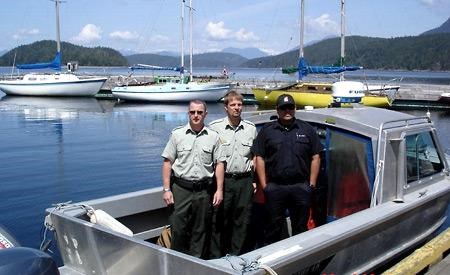A partnership with the provincial government will assist Tla’amin (Sliammon) First Nation in protecting heritage and cultural sites throughout its traditional territory.
Erik Blaney, coordinator of Tla’amin’s Guardian Watchmen program, and Kim Meyer, manager of compliance and enforcement for the south coast, ministry of forests, lands and natural resource operations, attended Powell River Regional District’s October 16 planning committee meeting to talk about the partnership.
Blaney said there are over 300 registered archaeological sites in Tla’amin’s traditional territory and many more will be registered in the next few years, as a result of a partnership with Simon Fraser University (SFU). The archaeological department has been working in the area for the past five years under a partnership agreement with Tla’amin and an additional five years has just been added to the agreement. The University of Saskatchewan has also done work in the area.
The Guardian Watchmen program was designed in 2006-2007 as a natural resource monitoring strategy. It started up in November 2009 and expanded to include archaeological site protection in March 2012. The program began by monitoring registered sites, Blaney said, then expanded to non-registered sites.
Blaney provided an overview of sites in the rural areas of the regional district that have been disturbed. In particular, there have been many burial sites desecrated in Area A, he said. “We’ve had at least four bodies go missing from BC Parks’ areas in Desolation Sound and the Malaspina complex over the last two years,” he said.
As well, there have been disturbances to burial boxes, Blaney said. One person actually chopped up a box and used it for kindling for a fire, he added.
There are many archaeological sites throughout the region that have been developed, including Shelter Point Regional Park on Texada Island, Blaney said. “We’ve had two archaeologists go to the Shelter Point site and they said it is probably one of the most massive sites in our territory,” he said. “It sprawled right around into Gillies Bay and it’s at least 2,600 years old.”
In September, a fire destroyed the concession and caretakers’ home in the park. The cleanup needs to be done in cooperation with Tla’amin and an archaeologist on site, Blaney said, and he has been working with Sean McGinn, manager of community services, about how the work should proceed.
Meyer said a number of provincial departments and agencies are part of a collaboration to protect heritage sites, including wildfire management, BC Parks, conservation office and the archaeological branch. All of them now help monitor the sites, Meyer said. “Most recently, SFU has offered resources to assist us as well,” she said. “It’s all coming together in a big way.”
In any compliance and enforcement program, education is the best tool for gaining compliance, Meyer said. “We are moving forward and we’re very excited about continuing to monitor these sites and assisting arch branch in being the eyes and ears across the province.”



